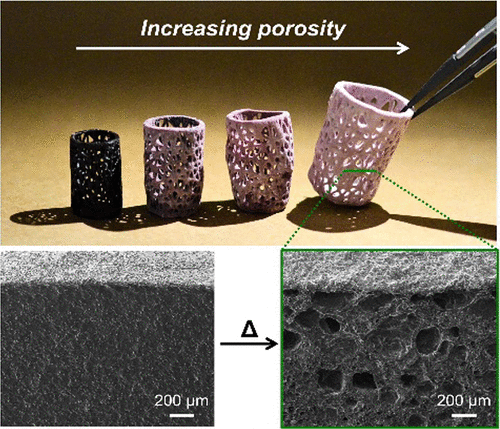当前位置:
X-MOL 学术
›
ACS Appl. Polym. Mater.
›
论文详情
Our official English website, www.x-mol.net, welcomes your
feedback! (Note: you will need to create a separate account there.)
Three-Dimensional Photochemical Printing of Thermally Activated Polymer Foams
ACS Applied Polymer Materials ( IF 4.4 ) Pub Date : 2021-09-10 , DOI: 10.1021/acsapm.1c00726 Soyoung E. Seo 1, 2 , Younghoon Kwon 2, 3 , Neil D. Dolinski 1, 2 , Caitlin S. Sample 1 , Jeffrey L. Self 4 , Christopher M. Bates 1, 2, 4 , Megan T. Valentine 2, 3 , Craig J. Hawker 1, 2, 4
ACS Applied Polymer Materials ( IF 4.4 ) Pub Date : 2021-09-10 , DOI: 10.1021/acsapm.1c00726 Soyoung E. Seo 1, 2 , Younghoon Kwon 2, 3 , Neil D. Dolinski 1, 2 , Caitlin S. Sample 1 , Jeffrey L. Self 4 , Christopher M. Bates 1, 2, 4 , Megan T. Valentine 2, 3 , Craig J. Hawker 1, 2, 4
Affiliation

|
Facile, on-demand manufacturing of polymer foams with desirable properties such as mechanical strength, controlled porosity, and varied composition will enable the design of custom structural components for a variety of applications. A two-step process based on initial 3D photopolymerization and subsequent thermal processing is reported for creating thermally activated polymer foams with tunable pore size and volume fraction. The overall resin design incorporates photopolymerizable monomers (matrix) and thermally expandable microspheres (foaming agent) to produce microporosity throughout the resulting polymer network. During the microscopic expansion process, 3D printed polymeric parts irreversibly expand while retaining their overall shape. Low-density foams with a porosity up to 85% have been produced that exhibit increased specific modulus and energy dissipation when compared to the bulk matrix and unexpanded 3D printed parts. In addition, by tuning the cross-link density of the matrix network, it is possible to control pore size and material mechanics. This approach produces thermally activated polymer foams of complex geometries with programmed porosity and enhanced mechanical properties with the two-step process also providing local control over the spatial distribution of pore sizes through multimaterial 3D printing.
中文翻译:

热活化聚合物泡沫的三维光化学印刷
具有所需特性(如机械强度、可控孔隙率和不同成分)的聚合物泡沫的轻松、按需制造将使设计用于各种应用的定制结构组件成为可能。据报道,基于初始 3D 光聚合和后续热处理的两步法可用于制造具有可调孔径和体积分数的热活化聚合物泡沫。整体树脂设计包含可光聚合单体(基质)和可热膨胀微球(发泡剂),以在整个所得聚合物网络中产生微孔。在微观膨胀过程中,3D 打印的聚合物部件在保持其整体形状的同时不可逆地膨胀。已生产出孔隙率高达 85% 的低密度泡沫,与块状基质和未膨胀的 3D 打印部件相比,其表现出更高的比模量和能量耗散。此外,通过调整基质网络的交联密度,可以控制孔径和材料力学。这种方法通过两步法生产具有复杂几何形状的热活化聚合物泡沫,具有程序化的孔隙率和增强的机械性能,还通过多材料 3D 打印提供对孔径空间分布的局部控制。
更新日期:2021-10-08
中文翻译:

热活化聚合物泡沫的三维光化学印刷
具有所需特性(如机械强度、可控孔隙率和不同成分)的聚合物泡沫的轻松、按需制造将使设计用于各种应用的定制结构组件成为可能。据报道,基于初始 3D 光聚合和后续热处理的两步法可用于制造具有可调孔径和体积分数的热活化聚合物泡沫。整体树脂设计包含可光聚合单体(基质)和可热膨胀微球(发泡剂),以在整个所得聚合物网络中产生微孔。在微观膨胀过程中,3D 打印的聚合物部件在保持其整体形状的同时不可逆地膨胀。已生产出孔隙率高达 85% 的低密度泡沫,与块状基质和未膨胀的 3D 打印部件相比,其表现出更高的比模量和能量耗散。此外,通过调整基质网络的交联密度,可以控制孔径和材料力学。这种方法通过两步法生产具有复杂几何形状的热活化聚合物泡沫,具有程序化的孔隙率和增强的机械性能,还通过多材料 3D 打印提供对孔径空间分布的局部控制。











































 京公网安备 11010802027423号
京公网安备 11010802027423号